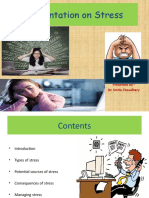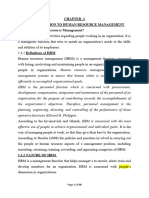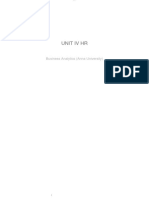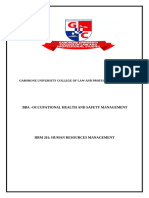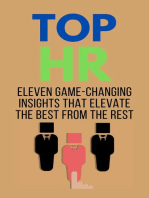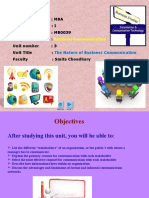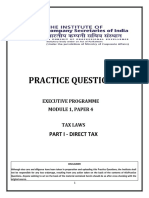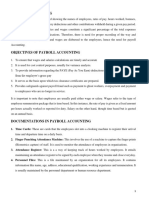SLM-Unit 01
SLM-Unit 01
Uploaded by
Dr. Smita ChoudharyCopyright:
Available Formats
SLM-Unit 01
SLM-Unit 01
Uploaded by
Dr. Smita ChoudharyCopyright
Available Formats
Share this document
Did you find this document useful?
Is this content inappropriate?
Copyright:
Available Formats
SLM-Unit 01
SLM-Unit 01
Uploaded by
Dr. Smita ChoudharyCopyright:
Available Formats
Human Resource Management
Unit 1
Unit 1
Introduction to Human Resource Management
Structure: 1.1 Introduction to Human Resource Management Objectives 1.2 Concept of Human Resource Management 1.3 Scope of Human Resource Management 1.4 History of Human Resource Management 1.5 Function of Human Resource Management 1.6 Role of HR Executives 1.7 Summary 1.8 Glossary 1.9 Terminal Questions 1.10 Answers 1.11 Case Study
1.1 Introduction to Human Resource Management
Every organisation is essentially a blend of material and Human Resource (HR). Material refers to money and machines pre-arranged by organisations for production or trade. Human Resource, on the other hand, refers to the knowledge, education, skills, training and ability of the members of the organisation. Human resources are the most valuable and unique assets of an organisation. The successful management of an organisation's human resources is an exciting, dynamic and challenging task, especially at a time when the world has become a global village and economies are in a state of change. The scarcity of talented resources and the growing expectations of the modern day worker have further increased the complexity of the human resource function. Even though specific human resource functions/activities are the responsibility of the human resource department, the actual management of human resources is the responsibility of all the managers in an organisation. In this unit, we shall look into the concept of Human Resource Management (HRM), its functions and roles in detail.
Sikkim Manipal University
Page No. 1
Human Resource Management
Unit 1
Objectives: After studying this unit, you should be able to: describe the concept of HRM define the scope of HRM describe the history of HRM explain the functions of human resource recognise the role of HR executives
1.2 Concept of Human Resource Management
Todays organisations constantly mould itself to meet the business challenges despite economic, political and social patterns in which it exists. The efforts made by organizations to sustain business metrics like revenue, profits and growth, market share is possible only through the people in the organization who work towards making this happen within the enterprise. One of the most useful definitions of Human Resources Management (HRM) is provided by Fisher, Schoendfelt and Shaw in their book Human Resources Management, HRM involves all management decisions and practices that directly affect or influence the people or Human resources who work for the organization. The concept of human resources entails: Total knowledge Skills Creative abilities Talents Aptitudes of an organisations workforce Values Attitudes Belief of the individuals involved A human resource manager has to build an effective workforce, handle the expectations of the employees and ensure that they perform at their best. He or she also has to take into account the firms responsibilities to the society that it operates in. It is therefore necessary for all managers to understand and give due importance to the different human resource policies and activities in the
Sikkim Manipal University Page No. 2
Human Resource Management
Unit 1
organisation. Human resource management outlines the importance of HRM and its different functions in an organisation. It examines the various HR processes that are concerned with attracting, managing, motivating and developing employees for the benefit of the organisation. Objectives of HRM The objectives of HRM can be classified into the following: To act as a link between the top management and the employees. To arrange and maintain adequate manpower inventory, which in turn, ensures the smooth working of the organisation. To offer training as a way of developing skills, enhancing productivity and most importantly, increasing individual and organisational performance to achieve the desired results. To devise employee benefit schemes for improving employee motivation and group morale, and enhancing employer-employee cooperation. To ensure and enhance the quality of work life, which refers to the employees perception of their physical and psychological well-being at work. To help keep up ethical values and behaviour amongst employees both within and outside the organisation. Self Assessment Questions Fill in the blanks: 1. A HR Manager has to build an effective ____________, handle the expectations of the employees and ensure that they perform at their best. 2. One of the major objectives of HRM is to act as a link between the ____________ and __________. 3. HRM examines the various HR processes that are concerned with attracting, managing, ______ and ______ employees for the benefit of the organisation.
1.3 Scope of Human Resource Management
In the previous section we discussed the concept and objectives of HRM. Let us now discuss the scope of HRM in an organisation.
Sikkim Manipal University
Page No. 3
Human Resource Management
Unit 1
The scope of HRM is wide and far-reaching. An understanding of HRM is important to anyone who is employed in an organisation. HR issues become important wherever there is a group of workers. Staffing is performed by all the managers as a managerial function, either directly or indirectly through HR department. All managers are, in this way, HR managers, since they get involved in HR activities such as selecting, training, inducting, compensating and motivating the employees along with industrial relations activities. We may classify the scope of HRM under the following heads:
HRM in personnel management This is typically direct manpower management that involves manpower planning, hiring (recruitment and selection), training and development, induction and orientation, transfer, promotion, compensation, layoff and retrenchment, and employee productivity. The overall objective is to ascertain individual growth, development and effectiveness which indirectly contribute to organisational development. It also includes performance appraisal, developing new skills, disbursement of wages, incentives, allowances, travelling policies and procedures, and other related courses of actions.
HRM in employee welfare This particular aspect of HRM deals with working conditions and amenities at the workplace. This includes a wide array of responsibilities and services such as safety services, health services, welfare funds, social security and medical services. It also covers appointment of safety officers, making the environment conducive for working, eliminating workplace hazards, support by top management, job safety, safeguarding machinery, cleanliness, proper ventilation and lighting, sanitation, medical care, sickness benefits, employment injury benefits, personal injury benefits, maternity benefits, unemployment benefits and family benefits. It also relates to supervision, employee counselling, establishing harmonious relationships with employees, education and training. Employee welfare is about determining employees real needs and fulfilling them with active participation of both the management and the employees. In addition to this, it also takes care of canteen facilities, crches, rest and lunch rooms, housing, transport, medical assistance, education, health and safety, recreation facilities, etc.
Sikkim Manipal University
Page No. 4
Human Resource Management
Unit 1
HRM in industrial relations Since employment relationship is a highly sensitive area, it needs careful interactions with labour or employee unions, address their grievances and effectively settle the disputes in order to maintain peace and harmony in the organisation. Industrial relations is the art and science of understanding the employment (unionmanagement) relations, joint consultations, disciplinary procedures, solving problems with mutual efforts, understanding human behaviour and maintaining work relations, collective bargaining and settlement of disputes. The main aim is to safeguard the interest of employees by securing the highest level of understanding to the extent that does not leave a negative impact on the organisation. It is about establishing, growing and promoting industrial democracy to safeguard the interests of both employees and management.
Self Assessment Questions Match the following: 4. Personnel management 5. Employee welfare 6. Industrial relations (a) working conditions and workplace amenities (b) promotes industrial democracy (c) Direct manpower management
1.4 History of Human Resource Management
In the previous unit we discussed the scope of HRM and its classification under different headings. Let us now discuss the history of HRM. There is a vast difference between modern HRM and the personnel management that was prevalent decades ago. By the end of the twentieth century, the managerial philosophy that had defined the personnel function had undergone radical changes. Over the past several years, scientific management approach and the human relations approach appeared and then disappeared too. However, the human resource approach has gained prominence in recent times.
Sikkim Manipal University
Page No. 5
Human Resource Management
Unit 1
Scientific management approach Fredrick Taylor, who is widely considered to be the father of scientific management, focused on motions that were required for each job, the tools used and the time needed to accomplish each task. Fair performance standards were then determined for each job, on the basis of such scientific data rather than on the superiors subjective judgment. Those workers whose output exceeded the standards were given additional incentive pay. The base of scientific management was solely motivated by money and led to many problems. Human relations approach The Hawthorne studies conducted during the 1930 and 1940s, forced organisations to shift their attention from scientific management approach to human relations approach. Hawthorne studies suggested that employee productivity was not only influenced by the way the job was designed and the economic rewards, but also by certain social and psychological factors. Feelings, emotions and sentiments of employees were greatly influenced by work conditions such as group relationships and management support. It was recognised that treating employees with respect would improve employee satisfaction and help in achieving higher productivity. Human resources approach Human resources approach treats people as resources, rather than factors of production, or as human beings who act on the basis of emotions alone. Some of the principles of human resource approach are: Employees are assets to an organisation. Policies, programmes and practices must cater to the needs of employees and should help them in their work and in their personal development. The job and tasks are the primary motivators for employees. Individual employee needs must be catered to maintain motivation. It is necessary to create and maintain a supportive work environment, to encourage the employees to develop and harness their knowledge and skills for the benefit of the organisation.
Sikkim Manipal University
Page No. 6
Human Resource Management
Unit 1
HR policies and practices should be in alignment with the goal of balancing individual and organisations needs. When employees are considered as assets and treated individually, the level of motivation improves. This leads to more committed and better employee performance. Overall increase in the performance of employees leads to an increased organisational performance. When the organisation reaps benefits out of the increased performance, it is bound to share some of it to the employees in the form of employee rewards. Employee rewards may be monetary such as hike in salary or increments or it may be non-monetary such as change in designation, status, fringe benefits, etc. When employees realise that they are rewarded and respected for their efforts they are further motivated. Thus, the human resource approach helps the employees to achieve through a mutual process where the organisation and the employees help each other to achieve their goals as shown in figure 1.1.
Employee Motivation
Employee Rewards
Employee Performance
Organisational Performance
Fig. 1.1: Human Resource Approach [Source: ICFAI Center for Management Research]
8
Self Assessment Questions Fill in the blanks: 7. _________ is considered to be the father of scientific management. 8. __________ suggested that employee productivity was not only influenced by the way the job was designed and the economic rewards but also by certain social and psychological factors.
Sikkim Manipal University
Page No. 7
Human Resource Management
Unit 1
9. __________ approach states that HR policies and practices should be in alignment with the goal of balancing individual and organisations needs. Activity 1: Browse the Internet and prepare a report on the implications of Hawthorne Studies. (Hint: Refer to: 1. http://www.enotes.com/hawthorne-experimentsreference/hawthorne-experiments 2. http://www.nwlink.com/~donclark/hrd/history/hawthorne.html) 3. http://www.accel-team.com/motivation/hawthorne_02.html
1.5 Function of Human Resource Management
In the previous section we discussed the history of HRM and analysed the various approaches towards HRM. Let us now describe the functions of HRM. Human resource management involves blending the traditional administrative functions along with the changing concepts of employee welfare in the organisation. Organisations now regard employees as a precious resource and spend more efforts to retain them. The retention of employees is dependent on how they are perceived and treated in the organisation based on their performance, abilities and skills. Human resource managers are involved right from identifying potential candidates for jobs to their separation from the organisation. They encourage communication amongst the employees and also promote better employer employee relationship. Organisational performance depends directly on how efficiently and effectively the HR department functions. It is the quality of the human resources available to the organisation that primarily determines the quality of the products and services produced by the organisation. The HR personnel are the key link between the top management and the employees. Today, HRM operates in tune with other essential organisational requirements and co-exists with the topmost management cadre. It thrives
Sikkim Manipal University Page No. 8
Human Resource Management
Unit 1
on the strength of the relationship between the management and the workers of the company. Figure 1.2 depicts the major functions that an HR manager has to carry out in any organisation. The extent of activities carried out by the HR is dependent on the size and scope of the organisation, the nature of operations and the attitude of management towards the employees.
MISSION OF AN ORGANISATION P L A N I N G
O R G A N I S I N G
D I R E C T I N G
C O N T R O L L I N G
VISION & OBJECTIVES
HRM OBJECTIVES STRATEGIES AND POLICIES OF HRM MANAGERIAL FUNCTIONS OF HRM OPERATIVE FUNCTIONS OF HRM
EMPLOYMENT
HUMAN RESOURCES DEVELOPMENT
CONPENSATION MANAGEMENT JOB EVALUATION
WAGE AND SALARY
EMPLOYEE RELATIONS MOTIVATION MORALE JOB SATISFACTION
HUMAN RESOURCES DEVELOPMENT RECRUITMENT
PERFORMANCE APPRAISAL TRAINING MANAGEMENT DEVELOPMENT PERFORMANCE APPRAISAL
SELECTION INDUCTION PLACEMENT
FRINGE BENEFTS
COMMUNICATION ORGANISATION CHANGE AND ORGANISATION DEVELOPMENT
GRIEVANCE AND 10 DISCIPLINARY PROCEDURE
Fig. 1.2: Flow Chart of Functions of HRM [Source: Rao, Subba (2011). Essentials of HRM and Industrial Relations, rd 3 Ed. Himalaya Publishing Pvt Ltd.]
HRM functions can be broadly classified into the following two categories: 1. Managerial functions 2. Operative functions Managerial functions of HR department The managerial functions of HR department include the following: Planning Future course of action; it also includes identifying human resource requirements and forecasting personnel needs.
Sikkim Manipal University
Page No. 9
Human Resource Management
Unit 1
Organising Division of labour; assignment of responsibility is part of the organisations functions. Staffing It is the process of obtaining and maintaining capable and competent personnel in various positions at all levels, i.e., manpower planning, recruitment, selection, placement and induction. Directing It is the process of directing all the available resources towards the common organisational goals. Controlling It is the measurement and rectification of activities to ensure that the events conform to plans.
Operative functions of HR department Operative functions of HR department are those core functions that only the HR department is assigned to perform. These include functions such as employment of new personnel, developing their skill sets, compensating them for their efforts and maintaining employee relations. Figure 1.3 depicts the operative functions of HRM.
Fig. 1.3: Operative Functions of HRM
Let us now discuss the operative functions of HRM. Employment Employment is the first operative function of HRM. This involves procuring and employing individuals with suitable knowledge, skills, experience and aptitude necessary to perform various jobs. It includes functions such as job analysis, human resource planning,
Page No. 10
Sikkim Manipal University
Human Resource Management
Unit 1
recruitment, selection, placement and induction. Figure 1.4 shows the different functions of employment.
Fig. 1.4: Functions of Employment
The various functions of employment are: a) Job analysis To ensure the satisfactory performance of an employee, his skills, abilities and motives to perform a job must match the requirements of the job.Job analysis is the process by which the tasks which comprise the job are determined and the skills and abilities required to perform it successfully are identified. b) HR planning HR planning involves forecasting the human resource requirements of an organisation and the future supply of human resources, and making suitable adjustments between the two in correlation with the organisational plans. c) Recruitment Recruitment is the process of seeking and attracting prospective candidates against a vacancy in the organisation. d) Selection The purpose of employment selection is to choose the right candidate for a job. e) Placement After a selected candidate conveys his or her acceptance of the offer of employment made by an organisation, his or her placement has to be decided based on the needs of the organisation.
Sikkim Manipal University
Page No. 11
Human Resource Management
Unit 1
f)
Induction Introducing a new employee to the organisation, the organisations business, its culture, values and beliefs, and practices and procedures is termed as induction.
HR development HR development concentrates on developing the workforce so that both the employees and the organisation in turn can achieve their goals. It focuses on strengthening the skills, knowledge and aptitudes of the employees. This includes functions starting with evaluating the performance of the employees, providing necessary training and development programmes to fill the gaps between current performances to the optimum performance of employees. HR development involves functions such as: a) Performance appraisal This is the process of evaluating the performance of an employee on the job and developing a plan for the employees improvement. This includes an assessment of the strengths and weaknesses of the employee, and drawing up a development plan in consultation with him or her to prepare him or her for future tasks and responsibilities in the organisation. b) Training Training is the systematic development of knowledge, skills and attitudes required to perform a given task or job successfully, in an individual. c) Management development It is the concept of developing the employees of an organisation to meet future changes and challenges. d) Career planning and development Career planning and development refers to identifying ones career goals and formulating plans forachieving them through various means such as education and work experience.
Compensation Compensation includes all the rewards that an employee receives during the course of his or her jobfor his or her contributions to the organisation. Compensation encompasses base salary, incentives, bonus and benefits, and is based on job evaluation. a) Job evaluation Job evaluationis a systematic determination of the value of each job in relation to other jobs in the organisation, in the industry and in the market.
Sikkim Manipal University
Page No. 12
Human Resource Management
Unit 1
b) Wage and salary administration Wage and salary administration is the process of formulating and operating a suitable wage and salary programme. c) Incentives Incentives are the rewards that an employee earns in addition to regular wages or salary based on the performance of the individual, the team or the organisation. d) Fringe benefits Fringe benefits are monetary and non-monetary benefits given to employees during their employment, and sometimes, also in the post-employment period. These include housing facilities, canteen facilities, conveyance facilities, educational facilities for employees and their children, medical and welfare facilities, company stores, etc. Employee relations Employee relations deals with the employees, in the organisational context, as a social group that contributes to the organisation. It includes: a) Increasing employee productivity. b) Keeping the employees satisfied and motivated. c) Developing team building, team management, leadership skills in employees. d) Designing and implementing a fast and suitable grievance management system. e) Ensuring discipline among the employees by prompt action to correct deviations. f) Supporting employees by counselling and developing them into complete individuals and responsible citizens. g) Enhancing the quality of both work and personal life of the employees.
Self Assessment Questions 10. __________ is the future course of action that includes identifying human resource requirements and forecasting personnel needs. 11. ___________ are the rewards that an employee earns in addition to regular wages or salary based on the performance of the individual, team or the organisation. 12. ____________ are monetary and non-monetary benefits given to employees during their employment.
Sikkim Manipal University Page No. 13
Human Resource Management
Unit 1
1.6 Role of HR Executives
In the previous section, we discussed the various functions involved in HRM. Let us now discuss the role of HR executives. Managing people is one of the biggest challenges for a manager. Few of the reasons are: Individuals differ from each other in terms of their values, attitudes, beliefs and culture. This leads to a very complex situation. The stimulating and motivational factors might not be the same for all employees. It is important to understand the individual needs of the employees and cater to those needs. This involves taking up different roles by the HR. The specialist role of HR manager includes: Services provider Administrative expert Facilitator Consultant Auditor Change agent Employee advocate Let us now look into each of these roles in detail. Service provider Management needs to gather information such as market statistics, pay rates and labour laws, and legislations from the market as well as from their competitors before making decisions on various employee related issues. Administrative expert The administrative role involves record keeping and legal compliance. The HR is responsible for maintaining all records of the employees relating to their employment and also ensuring the organisation complies to the statutory health and safety, employee welfare measures. Facilitator They act as a facilitator when training and development actions are planned and conducted,and when performance appraisals are done.
Sikkim Manipal University
Page No. 14
Human Resource Management
Unit 1
Consultant While supervising the employees, managers face many problems. Their problems may be due to lack of motivation, lack of training,job misfit and grievances relating to pay.They should know how to smoothly resolve such problems. Auditor HR specialists are responsible for ensuring that all members of the management perform their respective roles efficiently and also ensures that there is effective use of the human resources of the organization. Change agent It is the HR that helps organisations to implement changes and help employees adapt to changes. The HR is the first department that recognises the changes in the external environment and makes necessary changes within the organisation to help the organisation adjust to the changes without any hitches. When the market is not favourable, the HR may be busy with downsizing and when there are new prospects in future, the HR tries to ensure that the employees are well trained to take full advantage of it. Employee advocate HR employees are the link between the top management and the employees. The concerns of the employees are first reported to the HR personnel. They report these issues to the top management and try to resolve the issues.
Thus, we have seen that the HR in any organisation has multiple roles to play. No HR can perform just one role. They may have to perform all the mentioned roles at different stages in their career as HR personnel. Self Assessment Questions 13. The administrative role of the HR involves record keeping and ____________. 14. As an ___________ HR employees link the top management and employees. 15. As an _______ HR specialists are responsible for ensuring that all members of the management perform their respective roles concerned with the effective use of HR.
Sikkim Manipal University
Page No. 15
Human Resource Management
Unit 1
1.7 Summary
Let us recapitulate the important concepts discussed in this unit: Human resource management is one of the most complex and challenging field of management study. It mainly deals with people dimension in management. Over the past several years various approaches to human resource management have been adopted by companies. Scientific management approach gave rise to the human relations approach. The human resource approach has gained prominence in recent times valuing employees as the prime asset in any organisation. The primary objective of HRM is to take care of the work life of employees even while ensuring their best possible cooperation for achieving the organisational goals and objectives. The scope of HRM can be divided into HRM in personnel management, HR in employee welfare, HR in industrial relations. Basically, HRM includes the four functions of acquiring, developing, motivating and managing the human resources. HRM functions are broadly classified into two categories managerial and operative functions. Managerial functions include planning, organising, directing and controlling. The operative functions of HRM are related to specific activities of HRM such as employment, development, compensation and employee relation. The specialist role of the HR professional takes a number of roles, which is that of an auditor, service provider, administrative expert, facilitator, consultant, the change agent and employee advocate.
1.8 Glossary
Manpower inventory: A record of all the employees that lists all relevant employment related information such as age, sex, educational qualification, job history, type of employment, years of work experience. It helps in knowing the number of employees in a department and the job that they carry out.
Sikkim Manipal University
Page No. 16
Human Resource Management
Unit 1
Employee Retention: Employee retention refers to the various policies and practices which let the employees stick to an organization for a longer period of time. Hawthorne studies: In the 1920s Harvard Business School professor, Elton Mayo, and his Fritz J. Roethlisberger led a landmark study of worker behavior at Western Electric, Chicago. The study began by examining the physical and environmental influences of the workplace (e.g. brightness of lights, humidity) and later, moved into the psychological aspects (e.g. breaks, group pressure, working hours, managerial leadership). The major finding of the study was that almost regardless of the experimental manipulation employed, the production of the workers seemed to improve. The Hawthorne experiments brought to light ideas concerning motivational influences, job satisfaction; resistance to change, group norms, worker participation, and effective leadership.
1.9 Terminal Questions
1. What is human resources management? Discuss the scope of HRM. 2. Explain the functions of HRM. 3. Discuss the main features of human relation approach. How does it differ from scientific management? 4. Briefly describe the different roles of HR professional in business.
1.10 Answers
Self Assessment Questions 1. Workforce 2. Top management and the employees 3. motivating, developing 4. (c) direct manpower management 5. (a) Working conditions and workplace amenities 6. (b) promotes industrial harmony 7. Fredrick Taylor 8. Hawthorne studies
Sikkim Manipal University Page No. 17
Human Resource Management
Unit 1
9. Human Resource 10. Planning 11. Incentives 12. Fringe benefits 13. Legal compliance 14. Employeee Advocate 15. Auditor Terminal Questions 1. Human resource refers to total knowledge, skills, creative abilities, talents and individual aptitudes of an organisations workforce, as well as values, attitudes and beliefs of the individuals involved. A human resource manager has to build an effective workforce, handle the expectations of the employees and ensure that they perform at their best.For more details, refer section 1.2 2. HRM includes the four functions of acquiring, developing, motivating and managing the human resources. HRM functions are broadly classified into two categories-managerial and operative functions.For more details, refer section 1.5 3. The Hawthorne studies conducted during the 1930 and 1940s, forced organisations to shift their attention from scientific management approach to human relations approach. Hawthorne studies suggested that employee productivity was not only by the way the job was designed and the economic rewards, but also by certain social and psychological factors. For more details, refer section 1.4 4. HR professional takes a number of forms: the auditors role, the executives role, the facilitators role, the consultants role, and the service providers role. HRM objectives should align with the organisational objectives, and should balance them with the individual and social goals. For more details, refer section 1.6
Sikkim Manipal University
Page No. 18
Human Resource Management
Unit 1
1.11 Case Study
HR, The trendsetter? No longer is HR just a recruitment function; it is part of the company's overall strategy to achieve its business goals. With increased competition in every industry, the challenge for companies is to remain competitive, and are they doing just that? Industry experts give a bird's-eye view of a few HR trends in the months to come. Dayanand Allapur, Head HR, Tesco HSC, feels that in the months to come, there would be an increased focus on strengthening the employee brand and creating a workplace of choice' through various initiatives such as smarter employee policies, increased workplace interaction through new age social media tools and using technology to optimise systems and processes. "This would be augmented with greater focus on talent planning and development, thereby providing better career options to employees. The trend would also lean more towards the "human side" of companies such as how "green" are we and also focus on diversity and giving back to the community," says Allapur. What is in store? Ashish Srivastava, Director - HR, Canara HSBC Oriental Bank of Commerce Life Insurance: Work-life balance Organisations will look at ensuring higher flexibility with enhanced focus on overall productivity rather than mere number of hours. Employees would be encouraged to constantly up-skill themselves and learn to work "smarter" and carve time for value-added initiatives with colleagues and family. Staffing and Compensation Staffing will remain lean with higher demands on individual productivity - beyond specified KRAs, albeit all within the parameter of core organisational values. The concept of "Total Rewards" will be earnestly applied as organisations will make compensation more creative and competitive. Expect deliberate focus on variable pay plans and a higher ROI on compensation. "Recognition" would be a focal point to ensure sustained engagement whilst simultaneously encouraging increased performance differentiation. What the high-performing organisations will choose to do is to give a staff an overall sense of "a great total-deal" and not just a good fixed base in compensation.
Sikkim Manipal University Page No. 19
Human Resource Management
Unit 1
Talent Management What will matter is the "Employment Brand" and existent talent, just as much as product loyalty will differentiate the top players in the industry. For instance, propel increase in the breadth of experience resulting in versatile workforce within the organisation through means of short-term and cross functional projects and assignments. Deepak Kaistha, Director, Planman Consulting Work-life Balance Work-life balance is just not a simple term but the way one should maintain/divide their work hours effectively. What will matter in the months to come is how you work smart and complete a defined task at a given time frame. Employees who are able to manage the same will be termed smart' workers. Staffing and Compensation Hiring plans for the next quarter is on its spree and looks optimistic. As per a study, employers in various industry sectors and all four regions of India report positive hiring plans for the next three months. Job seekers in the wholesale and retail trade sector (+51 per cent) and service sector (+48 per cent) can look forward to the most vigorous hiring in the next three months. Globally, the third quarter hiring expectations are positive, India being the strongest country, apart from Brazil, Taiwan, Turkey and Singapore. Talent Management Given ample evidence that companies with highly engaged employees outperform companies with neutrally or negatively engaged employees, over the next few years we'll see more companies adopt - not just talk about - best practices such as closer scrutiny of manager quality, continuous feedback, talent mining and mobility, workforce segmentation, employee recognition programmes and differentiated pay. Rajesh Padmanabhan, Head-HR, Capgemini India Work-life balance is an important ingredient of driving company culture and employer of choice value proposition. India Inc. will see more expectations around this and will need to ready organisations keeping this important aspect in mind. Staffing and Compensation as a recruitment channel is set to increase, going forward. More structured compensation options in the form of time-off, remote working, project allowance and performance accelerators would slowly start coming into play.
Sikkim Manipal University Page No. 20
Human Resource Management
Unit 1
Talent Management Structured capability building models and building future leaders will be the way forward. Whatever the route, HR is all set to pull up its sleeves and become the new trend-setter. Discussion Questions 1. What are the trends in staffing ? 2. What are the ways of ensuring talent management ?
(Source: http://www.itsmyascent.com/web/itsmyascent/hr-zone/-/ asset_publisher/4htH/content/hr-the-trendsetter
(Retrieved on 27th February, 2012) References: Bearwell, I, & Holden, L. (1995). Human Resource Management: A Contemporary Perspective. New Delhi: Macmillan India Limited. Dessler, G, & Verkkey, B. (2011). Human Resource Management. New Delhi: Pearson Prentice Hall. Durai, P. (2010). Human Resource Management. New Delhi: Pearson Publication.
E-Reference: http://www.managementstudyguide.com/scope-of-human-resourcemanagement.htm (Retrieved on 20 December 2011 ) http://www.slideshare.net/hemanthcrpatna/procedures-for-handlingdisciplinary-matters-in-ktms (Retrieved on 20 December 2011 )
Sikkim Manipal University
Page No. 21
You might also like
- Secondment Agreement SampleDocument2 pagesSecondment Agreement SampleDominique Delos Santos100% (12)
- Project BBA Final YearDocument12 pagesProject BBA Final YearMeh Nisha63% (8)
- The Modern HR Handbook: An Easy, Quick, and Handy Human Resource Guide for Any HR Manager or HR ProfessionalFrom EverandThe Modern HR Handbook: An Easy, Quick, and Handy Human Resource Guide for Any HR Manager or HR ProfessionalNo ratings yet
- Presentation On StressDocument31 pagesPresentation On StressDr. Smita Choudhary100% (1)
- 106 HRM - All - in - OneDocument281 pages106 HRM - All - in - OneDilip GoliyaNo ratings yet
- Unit 01 - Introduction To Human Resource ManagementDocument21 pagesUnit 01 - Introduction To Human Resource ManagementgarimaNo ratings yet
- Mba 43Document281 pagesMba 43Tabitha JohnsonNo ratings yet
- Unit 01 - Introduction To Human Resource Management - Manipal UniversityDocument24 pagesUnit 01 - Introduction To Human Resource Management - Manipal UniversityPraveen ParocheNo ratings yet
- Managing People and Organisations 4-6Document140 pagesManaging People and Organisations 4-6drsoniebhardwajNo ratings yet
- Introduction To: Human ResourceDocument28 pagesIntroduction To: Human Resourcechin22100% (3)
- HRM TERMINAL QUESTION Solved..Document72 pagesHRM TERMINAL QUESTION Solved..Vijin VinodNo ratings yet
- PDF document-30E69A9DE318-1Document123 pagesPDF document-30E69A9DE318-1Samarth SharmaNo ratings yet
- Human Resource ManagementDocument49 pagesHuman Resource ManagementVictor Munene MuchiriNo ratings yet
- Human Resource Management BBA 1st YearDocument172 pagesHuman Resource Management BBA 1st Yearཟླ་བ་ ཆོས་སྒྲོན་་No ratings yet
- Human Resource Management-BBA 2nd SemDocument16 pagesHuman Resource Management-BBA 2nd Semsunny_live0975% (20)
- Unit-I:: Introduction To Human Resources Management and EnvironmentDocument16 pagesUnit-I:: Introduction To Human Resources Management and EnvironmentmyadaarshikareddyNo ratings yet
- Assignment ON: Human Resource ManagementDocument22 pagesAssignment ON: Human Resource ManagementpuneetbabutaNo ratings yet
- CH 1 - 0Document8 pagesCH 1 - 0wubeNo ratings yet
- HRM 2Document118 pagesHRM 2Usha TamilselvanNo ratings yet
- Unit1 HRM-2Document65 pagesUnit1 HRM-2mayuri251105No ratings yet
- HRMDocument118 pagesHRMKarthic KasiliaNo ratings yet
- HRM NotesDocument49 pagesHRM Notesvenkatesan thilagarNo ratings yet
- 1 (HRM Intro)Document8 pages1 (HRM Intro)Pragya ChakshooNo ratings yet
- HRM Basic NotesDocument24 pagesHRM Basic NotesStuti Aggarwal 2K21/BBA/148No ratings yet
- HRM HandoutDocument98 pagesHRM Handoutetebark h/michaleNo ratings yet
- ccw331 Business Analytics Unit-Iv NotesDocument112 pagesccw331 Business Analytics Unit-Iv Notesanibernishsam27No ratings yet
- Human Resource ManagementDocument10 pagesHuman Resource Managementgeetha_mba2787No ratings yet
- HRM Module 1Document18 pagesHRM Module 1Riya SinghNo ratings yet
- Dharmaraj Project Front PageDocument76 pagesDharmaraj Project Front PageSweety RoyNo ratings yet
- TQMDocument128 pagesTQMChandan RaiNo ratings yet
- HRM HandoutDocument98 pagesHRM Handoutetebark h/michaleNo ratings yet
- Final PrintDocument63 pagesFinal PrintSai VivekNo ratings yet
- Edwin Flippo Defines-Human Resource Management As "Planning, OrganizingDocument12 pagesEdwin Flippo Defines-Human Resource Management As "Planning, OrganizingTArun MoHiteNo ratings yet
- Module 1Document39 pagesModule 1Dada KalandarNo ratings yet
- Contemporary Issues in HRMDocument14 pagesContemporary Issues in HRMTaruntej Singh50% (2)
- Human Resource ManagementDocument25 pagesHuman Resource ManagementAshutosh SinghNo ratings yet
- Intro HRMDocument7 pagesIntro HRMSunita BasakNo ratings yet
- RandS Module1Document6 pagesRandS Module1Lingahan EricaNo ratings yet
- Itm 322 Human Resource Management Chapter 1 4Document23 pagesItm 322 Human Resource Management Chapter 1 4Ma Arnelyn Baltar AniNo ratings yet
- SuhasDocument61 pagesSuhasSyed UmarNo ratings yet
- HRM Unit 1Document28 pagesHRM Unit 1mayursagarsharedNo ratings yet
- HRM FinalDocument95 pagesHRM FinalSachin Sachu100% (1)
- Unit - 1 Introduction To Human Resource ManagementDocument23 pagesUnit - 1 Introduction To Human Resource ManagementMani KrishNo ratings yet
- Human Resources Management Subject Code: IE: 3008 CH - 1: Introduction To Human Resource ManagementDocument19 pagesHuman Resources Management Subject Code: IE: 3008 CH - 1: Introduction To Human Resource Managementroshna jeonNo ratings yet
- What Is HRMDocument6 pagesWhat Is HRMDesh Bandhu KaitNo ratings yet
- HRM Basic NotesDocument343 pagesHRM Basic Notess.rajashreenadig05No ratings yet
- LEADERSHIPDocument50 pagesLEADERSHIPDrParul ChaubeyNo ratings yet
- Course Name: Human Resource Management (HRM)Document14 pagesCourse Name: Human Resource Management (HRM)Rosell SumogatNo ratings yet
- Initiation To HRM L100Document26 pagesInitiation To HRM L100Bonkiyou MohamedNo ratings yet
- HRM Unit 1Document34 pagesHRM Unit 1Akshita LambaNo ratings yet
- BHM 702TDocument148 pagesBHM 702TUtkarsh Kumar100% (1)
- Introduction To Human Resource ManagementDocument111 pagesIntroduction To Human Resource ManagementYogen PanchalNo ratings yet
- Human Resource Management: DefinedDocument5 pagesHuman Resource Management: DefinedLubnaskNo ratings yet
- Human Resource ManagementDocument5 pagesHuman Resource Managementjocelyn galoniaNo ratings yet
- HRM in Insurance Sector WRT Recruitment and SelectionDocument57 pagesHRM in Insurance Sector WRT Recruitment and SelectionAnushriAdarshRathiNo ratings yet
- HRM (Concept, Relevance and Functions)Document8 pagesHRM (Concept, Relevance and Functions)Danìél Koùichi HajongNo ratings yet
- Assignment 1 HRM HIMANSHUDocument20 pagesAssignment 1 HRM HIMANSHUHimanshu PaliwalNo ratings yet
- HRM ManualDocument217 pagesHRM ManualTawanda Leonard CharumbiraNo ratings yet
- Human Resource Management ModuleDocument12 pagesHuman Resource Management Modulefloresmarichu57No ratings yet
- Top HR: Eleven Game-Changing Insights That Elevate The Best From The RestFrom EverandTop HR: Eleven Game-Changing Insights That Elevate The Best From The RestNo ratings yet
- Notes: Sikkim Manipal University Page No. 303Document2 pagesNotes: Sikkim Manipal University Page No. 303Dr. Smita ChoudharyNo ratings yet
- MB0038 Management Process and Organizational Behavior Units 6-10Document16 pagesMB0038 Management Process and Organizational Behavior Units 6-10Dr. Smita ChoudharyNo ratings yet
- MB0043 Human Resource Management Units 6-10Document20 pagesMB0043 Human Resource Management Units 6-10Dr. Smita ChoudharyNo ratings yet
- MB0040 Statistics For Management Units 1-5Document40 pagesMB0040 Statistics For Management Units 1-5Dr. Smita ChoudharyNo ratings yet
- MB0043 Human Resource Management Units 1-5Document22 pagesMB0043 Human Resource Management Units 1-5Dr. Smita ChoudharyNo ratings yet
- Unit11 - 1 Mark Quiz Questions: MB0043 Human Resource Management Units 11-16Document16 pagesUnit11 - 1 Mark Quiz Questions: MB0043 Human Resource Management Units 11-16Dr. Smita ChoudharyNo ratings yet
- MB0041 Financial and Management Accounting Units 1-5Document36 pagesMB0041 Financial and Management Accounting Units 1-5Dr. Smita ChoudharyNo ratings yet
- MB0042 Managerial Economics Units 1-5Document47 pagesMB0042 Managerial Economics Units 1-5Dr. Smita ChoudharyNo ratings yet
- BBA102-MQP With Answers PDFDocument18 pagesBBA102-MQP With Answers PDFDr. Smita Choudhary100% (1)
- Book Code - MB 0043 (HRM) : Dr. Smita Choudhary Faculty HR & OBDocument26 pagesBook Code - MB 0043 (HRM) : Dr. Smita Choudhary Faculty HR & OBDr. Smita ChoudharyNo ratings yet
- Unit-03 The Nature of Busi. Comm.Document15 pagesUnit-03 The Nature of Busi. Comm.Dr. Smita ChoudharyNo ratings yet
- BBA101 PPT Unit 05Document17 pagesBBA101 PPT Unit 05Dr. Smita ChoudharyNo ratings yet
- QM0023 - Unit 1Document30 pagesQM0023 - Unit 1Dr. Smita ChoudharyNo ratings yet
- MU0017 Talent ManagementDocument12 pagesMU0017 Talent ManagementDr. Smita ChoudharyNo ratings yet
- SLM-Unit 06Document16 pagesSLM-Unit 06Dr. Smita ChoudharyNo ratings yet
- Annual Survey of Industries (Asi)Document6 pagesAnnual Survey of Industries (Asi)Abhijeet KumarNo ratings yet
- Actgov QuestionsDocument18 pagesActgov QuestionsMelvin BagasinNo ratings yet
- Psychology of Negotiation - Nick KolendaDocument37 pagesPsychology of Negotiation - Nick KolendaSergiu Sergio100% (1)
- Quirino State University: The Economic and Political Impact of TourismDocument5 pagesQuirino State University: The Economic and Political Impact of TourismSantana ShaneNo ratings yet
- Labstan 2015 2nd Yr (Complete)Document66 pagesLabstan 2015 2nd Yr (Complete)BANanaispleetNo ratings yet
- Quality of Work Life, Job SatisfactionDocument9 pagesQuality of Work Life, Job SatisfactionVenkates PsnaNo ratings yet
- Employment Contract For Student Part-TimersDocument5 pagesEmployment Contract For Student Part-TimersPillows100% (1)
- Chapter 12 Tds & TcsDocument28 pagesChapter 12 Tds & TcsRajNo ratings yet
- Enga11 Vocabulary Worksheet 13 Confusing WordsDocument2 pagesEnga11 Vocabulary Worksheet 13 Confusing WordsAnicaSalaticSantosNo ratings yet
- 2011.12.05 Making Toys Without JoyDocument21 pages2011.12.05 Making Toys Without JoyYi Yi DebbyNo ratings yet
- Practice QuestionsDocument133 pagesPractice QuestionsSarath KumarNo ratings yet
- SAP HR Payroll Implemantation StudyDocument19 pagesSAP HR Payroll Implemantation StudyAvi Nandy100% (1)
- Leave Rules NarasimhaDocument13 pagesLeave Rules NarasimhaPargunanNo ratings yet
- Abrpb4480f Partb 2020-21Document3 pagesAbrpb4480f Partb 2020-21Subray N BanaulikarNo ratings yet
- Summary of Government ComplianceDocument11 pagesSummary of Government Compliancekhalil rebatoNo ratings yet
- Mudit Mittal Project ReportDocument75 pagesMudit Mittal Project ReportAshish BangaNo ratings yet
- Writing Task 2 Vstep - D NG Bài: OpinionDocument16 pagesWriting Task 2 Vstep - D NG Bài: OpinionAnh ThưNo ratings yet
- Uvais Offer LetterDocument4 pagesUvais Offer LetterFarzeen NPNo ratings yet
- How To Pass An Interview For An IT Position?Document49 pagesHow To Pass An Interview For An IT Position?cristi mitroiNo ratings yet
- Time ManagementDocument11 pagesTime ManagementSàtísh TéñdúlkárNo ratings yet
- Final Business PlanDocument49 pagesFinal Business PlanNicole C. RoniNo ratings yet
- Simon Task 2Document37 pagesSimon Task 2Hoàng LongNo ratings yet
- Chairman's Report On The Agreement Establishing The EBRDDocument7 pagesChairman's Report On The Agreement Establishing The EBRDVeronika PshenychnykovaNo ratings yet
- New Milma InternshipDocument48 pagesNew Milma InternshipJissa Joseph100% (1)
- HR Policy ListDocument11 pagesHR Policy Listrkarjee100% (1)
- Randstad Malaysia 2024 Market Outlook Salary Guide Digital Report CompressedDocument32 pagesRandstad Malaysia 2024 Market Outlook Salary Guide Digital Report Compressedcqdpgfpc62No ratings yet
- Payroll AccountingDocument4 pagesPayroll AccountingADEYANJU AKEEMNo ratings yet
- Employment ContractDocument4 pagesEmployment Contractink.ink2013No ratings yet
- Severance Package - Summary by YOSDocument2 pagesSeverance Package - Summary by YOSSandy RatulangieNo ratings yet




